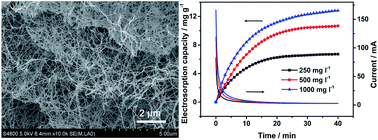Ultra-thin carbon nanofiber networks derived from bacterial cellulose for capacitive deionization†
Abstract
Ultra-thin carbon nanofiber networks (bc-CNFs) were prepared from natural-based bacterial cellulose pellicle through freeze drying and subsequent carbonization at different temperatures. The morphology, structure and electrochemical performance of the bc-CNFs were characterized by field emission scanning electron microscopy, transmission electron microscopy, Raman spectroscopy, nitrogen adsorption–desorption, Fourier transform infrared spectroscopy, cyclic voltammetry and electrochemical impedance spectroscopy. Their electrosorption performance in NaCl solution was studied and compared with those of carbon nanotubes (CNTs) and electrospun carbon nanofibers (e-CNFs). The results show that the bc-CNFs treated at 800 °C exhibited excellent desalination performance with an electrosorption capacity of 12.81 mg g−1 in 1000 mg l−1 NaCl solution, much higher than those of the CNTs (3.78 mg g−1) and the e-CNFs (6.56 mg g−1). The excellent performance of the bc-CNFs is ascribed to their high specific surface area, low charge transfer resistance and superior hydrophility.


 Please wait while we load your content...
Please wait while we load your content...